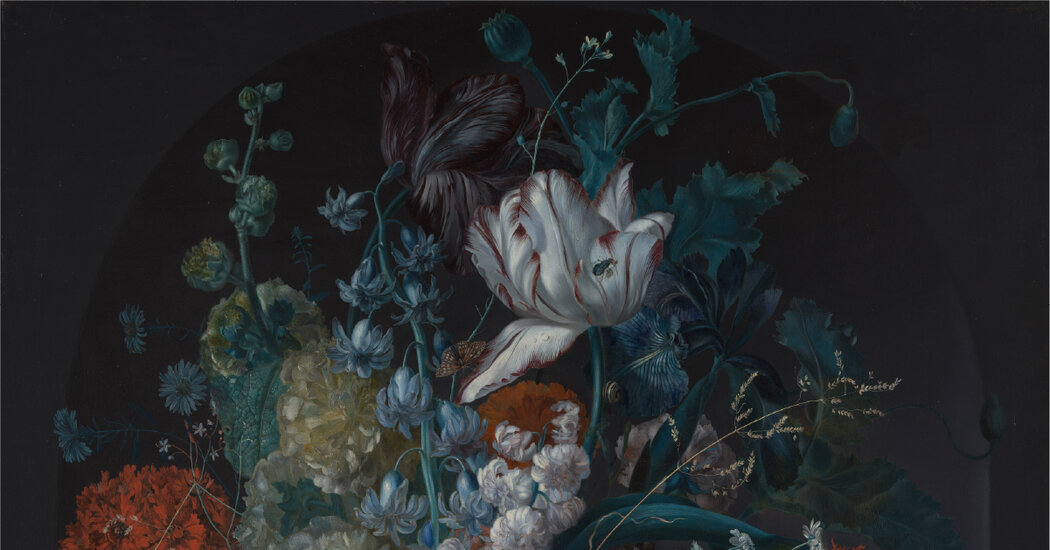You made it in time. If you want to look a little longer, just scroll back up and press “Continue.”
There’s a story about an ancient Greek painter named Zeuxis who, in a painting contest with a rival, painted grapes so realistic that birds flew down and tried to eat them. As I looked at these grapes by Margareta Haverman at the Metropolitan Museum of Art last week, I could imagine birds breaking through the ceiling, swooping right in.
A technical analysis of the painting revealed Haverman used up to seven layers of paint on the grapes, some added while the previous layer was still wet, to achieve the effect—evidence of an artist searching for the perfect form. Everywhere your eyes look, they encounter a torrent of detail: the intricate layers of the flower petals, the blushing of the fruit, the patterns on the wings of the bugs, the shine of the water droplets, and the veins on the leaves.
Interestingly, the leaves are bluer now than they would have been in 1716 because the yellow pigment Haverman used faded over time. Even with this bluer cast, there remains a wide range of color: shocking reds, paler blues, bright whites, and deep purples.
You can picture Haverman in her studio with this setup in front of her, looking, sketching, and painting—racing against the clock before her beautiful bouquet wilts and dies. Remember, it’s 1716: she can’t take a photograph.
But that’s not possible.
“This bouquet could never exist in reality,” said Adam Eaker, assistant curator in the Department of European Paintings at the Met. “These flowers don’t bloom at the same time of year, so Haverman would have slowly pieced this work together on the basis of individual studies.”
In all, there are 30 different types of fruit and flowers, two species of butterfly, five other types of insects, and a couple of garden snails. This is one of only two surviving works by Haverman.
Little is known about her life, but we do know she learned these techniques from a highly regarded flower painter, Jan van Huysum.
Take a look at this van Huysum painting from 1715. Can you see the similarities between Haverman (left) and van Huysum (right), particularly in the tulips? Haverman learned fast. She was good. Van Huysum was jealous.
A 1751 biography of the eccentric and secretive van Huysum — who came from a family of painters and wouldn’t even let his brothers see the inside of his studio — notes that Haverman’s “prowess aroused Jan’s envy to such a degree that he longed to be rid of her.”
Female painters were rare and often needed a family connection to enter the field. (Haverman’s father helped persuade van Huysum to take her on.) Many women were relegated to still life painting because they weren’t allowed to study nude models.
Still, Haverman excelled. The same biography notes she learned “not only to copy [van Huysum’s] paintings but also to paint beautifully from life; even to the amazement of connoisseurs, who came to see her work.”
Eventually, van Huysum found a reason to drop her as his student. (It was described at the time as a “misdeed.”)
Haverman’s self-assurance is clear in the decisions she makes in this painting. Notice how the dark background causes that streak of white flowers to push even more to the fore, providing a central anchor for your eye.
Zoom in (you may need to get up close) and you can just make out her signature at the bottom, almost etched into the plinth.
“I love the confidence of her signature and the strange sculptural ornamentation of the vase, lurking in the shadows,” Mr. Eaker said. “I think the signature gives a wonderful sense both of Haverman’s confidence as an artist and her skill at crafting an illusion.”
Flower painting like this was common in the Netherlands. Even a hundred years earlier, artists like Ambrosius Bosschaert the Elder were setting similarly striped tulips in arrangements against landscape backgrounds.
Around this time, in the early 1600s, so-called “tulip mania” hit the Netherlands. In the craze, the price of tulip bulbs was bid up and up—selling in one case for more than a Rembrandt painting—creating what some describe as the first financial bubble.
Eventually, the bubble burst and tulip prices came crashing down, leaving some tulip speculators bankrupt.
Tulip mania was later followed by the hyacinth mania of the 1700s. Haverman included blue and white varieties of hyacinth in our painting.
There’s a temptation to want to extract symbolism or meaning from these flowers. Maybe Haverman painted some parts of this bouquet not at their peak but in decay to remind us of the fragility of life.
“Some flowers do have symbolic meaning, but flower paintings generally weren’t meant to be ‘decoded,’” Mr. Eaker said.
In the end, the bouquet of flowers you bought from the corner store last weekend will die. This painting, with the help of art conservators, will live.
These are objects for close looking and admiration, Mr. Eaker said, “particularly on a cold gray Dutch winter’s day.”
https://www.nytimes.com/interactive/2025/11/02/upshot/ten-minute-challenge-flowers.html
